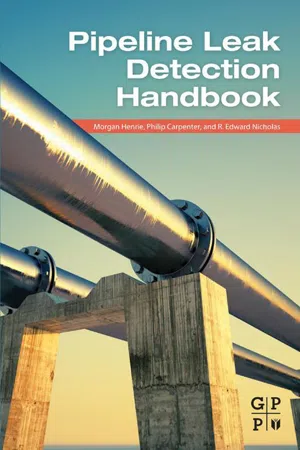
- 340 pages
- English
- ePUB (mobile friendly)
- Available on iOS & Android
Pipeline Leak Detection Handbook
About this book
Pipeline Leak Detection Handbook is a concise, detailed, and inclusive leak detection best practices text and reference book. It begins with the basics of leak detection technologies that include leak detection systems, and information on pipeline leaks, their causes, and subsequent consequences.The book moves on to further explore system infrastructures, performance, human factors, installation, and integrity management, and is a must-have resource to help oil and gas professionals gain a comprehensive understanding of the identification, selection, design, testing, and implantation of a leak detection system.- Informs oil and gas pipeline professionals on the basics of leak detection technologies, the required field instrumentation, telecommunication infrastructures, human factors, and risk mitigation considerations- Leads the reader through the complex process of understanding the pipeline's unique environment and how to develop a leak detection program
Frequently asked questions
- Essential is ideal for learners and professionals who enjoy exploring a wide range of subjects. Access the Essential Library with 800,000+ trusted titles and best-sellers across business, personal growth, and the humanities. Includes unlimited reading time and Standard Read Aloud voice.
- Complete: Perfect for advanced learners and researchers needing full, unrestricted access. Unlock 1.4M+ books across hundreds of subjects, including academic and specialized titles. The Complete Plan also includes advanced features like Premium Read Aloud and Research Assistant.
Please note we cannot support devices running on iOS 13 and Android 7 or earlier. Learn more about using the app.
Information
Introduction
Abstract
Keywords
1.1 Introduction
Table of contents
- Cover image
- Title page
- Table of Contents
- Copyright
- Chapter 1. Introduction
- Chapter 2. Pipeline Leak Detection Basics
- Chapter 3. Mass Balance Leak Detection
- Chapter 4. Real-Time Transient Model–Based Leak Detection
- Chapter 5. Statistical Processing and Leak Detection
- Chapter 6. Rarefaction Wave and Deviation Alarm Systems
- Chapter 7. External and Intermittent Leak Detection System Types
- Chapter 8. Leak Detection System Infrastructure
- Chapter 9. Leak Detection Performance, Testing, and Tuning
- Chapter 10. Human Factor Considerations in Leak Detection
- Chapter 11. Implementation and Installation of Pipeline Leak Detection Systems
- Chapter 12. Regulatory Requirements
- Chapter 13. Leak Detection and Risk-Based Integrity Management
- Index